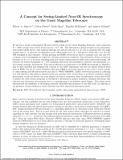A concept for seeing-limited near-IR spectroscopy on the Giant Magellan Telescope
Author(s)
Furesz, Gabor; Egan, Mark; Hellickson, Timothy H; Malonis, Andrew C.; Simcoe, Robert A.
DownloadA concept for seeing.pdf (3.095Mb)
PUBLISHER_POLICY
Publisher Policy
Article is made available in accordance with the publisher's policy and may be subject to US copyright law. Please refer to the publisher's site for terms of use.
Terms of use
Metadata
Show full item recordAbstract
We present a simple seeing-limited IR spectrometer design for the Giant Magellan Telescope, with continuous R = 6000 coverage from 0.87-2.50 microns for a 0:7” slit. The instrument's design is based on an asymmetric white pupil echelle layout, with dichroics splitting the optical train into yJ, H, and K channels after the pupil transfer mirror. A separate low-dispersion mode offers single-object R ~ 850 spectra which also cover the full NIR bandpass in each exposure. Catalog gratings and H2RG detectors are used to minimize cost, and only two cryogenic rotary mechanisms are employed, reducing mechanical complexity. The instrument dewar occupies an envelope of 1:8×1:5×1:2 meters, satisfying mass and volume requirements for GMT with comfortable margin. We estimate the system throughput at ~ 35% including losses from the atmosphere, telescope, and instrument (i.e. all coatings, gratings, and sensors). This optical efficiency is comparable to the FIRE spectrograph on Magellan, and we have specified and designed fast cameras so the GMT instrument will have an almost identical pixel scale as FIRE. On the 6.5 meter Magellan telescopes, FIRE is read-noise limited in the y and J bands, similar to other existing near-IR spectrometers and also to JWST/NIRSPEC. GMT's twelve-fold increase in collecting area will therefore offer gains in signal-to-noise per exposure that exceed those of moderate resolution optical instruments, which are already sky-noise limited on today's telescopes. Such an instrument would allow GMT to pursue key early science programs on the Epoch of Reionization, galaxy formation, transient astronomy, and obscured star formation environments prior to commissioning of its adaptive optics system. This design study demonstrates the feasibility of developing relatively affordable spectrometers at the ELT scale, in response to the pressures of joint funding for these telescopes and their associated instrument suites.
Date issued
2016-08Department
Massachusetts Institute of Technology. Department of Physics; MIT Kavli Institute for Astrophysics and Space ResearchJournal
Proceedings of SPIE--the Society of Photo-Optical Instrumentation Engineers
Publisher
SPIE
Citation
Simcoe, Robert A., Gábor Fűrész, Mark Egan, Timothy Hellickson, and Andrew Malonis. “A Concept for Seeing-Limited Near-IR Spectroscopy on the Giant Magellan Telescope.” Edited by Christopher J. Evans, Luc Simard, and Hideki Takami. Ground-Based and Airborne Instrumentation for Astronomy VI (August 9, 2016).
Version: Final published version
ISSN
0277-786X